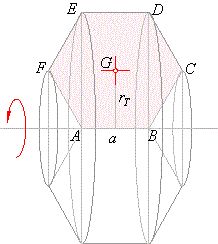|
| Applications
of Trigonometry |
|
 Applications
of Trigonometry in Solid Geometry
Applications
of Trigonometry in Solid Geometry |
 Volume
and Surface Area of Solids of Revolution, Guldin’s Rules
Volume
and Surface Area of Solids of Revolution, Guldin’s Rules |
|
|
|
|
|
|
|
|
|
|
Volume
and Surface Area of Solids of Revolution, Guldin’s Rules
|
|
A regular hexagon of the side
a, rotates around an axe which passes through one of its sides, determine the
surface area and the volume of generated solid of revolution.
|
|
The surface area equals to the lateral surface of
a cylinder and lateral surfaces of two conical frustums, and lateral surfaces of two conics.
Therefore,
|
 |
|
Volume of the solid of revolution equals
to the volume of the cylinder plus volumes of two conical frustums minus volume of two conics,
that is
|
 |
|
 |
|
|
|
|
The same result can be obtained applying
Guldin’s rules that states,
|
|
1) Surface area of a solid generated by rotation of a plane curve (a geometric figure) around an axe, which lies in the same plane but which do not intersect, equals to the product of the lengths of the curve (the figure’s perimeter) and the perimeter of the circle described by the centroid of the curve (the centroid of the
figure)
|
| therefore, |
S = P
· PG =
P
· 2p
· rG |
|
|
|
Thus, applied to the preceding
example, the centroid of the regular hexagon coincides with its center so, the perimeter of the circle described by the
centroid,
|

|
|
and the perimeter of the regular hexagon
P = 6a, plugging into above formula gives
|
|
S = P
· 2p
· rG =
6a
· Ö3pa =
6Ö3p
· a2.
|
|
2) Volume of a solid of revolution generated by the rotation of a figure around an axe which lies in the same
plane as the figure, but which do not intersect, is equal to the product of the area of the figure and the
perimeter of the circle described by the centroid of the figure,
|
| therefore, |
V = A
· PG =
A
· 2p
· rG |
|
|
|
Thus, for the volume of the solid of revolution from the preceding example
|

|
|
|
|
|
|
|
|
|
|
|
|
|
|
|
|
|
|
|
| Geometry
and use of trigonometry contents - B |
|
|
 |
|
| Copyright
© 2004 - 2020, Nabla Ltd. All rights reserved. |